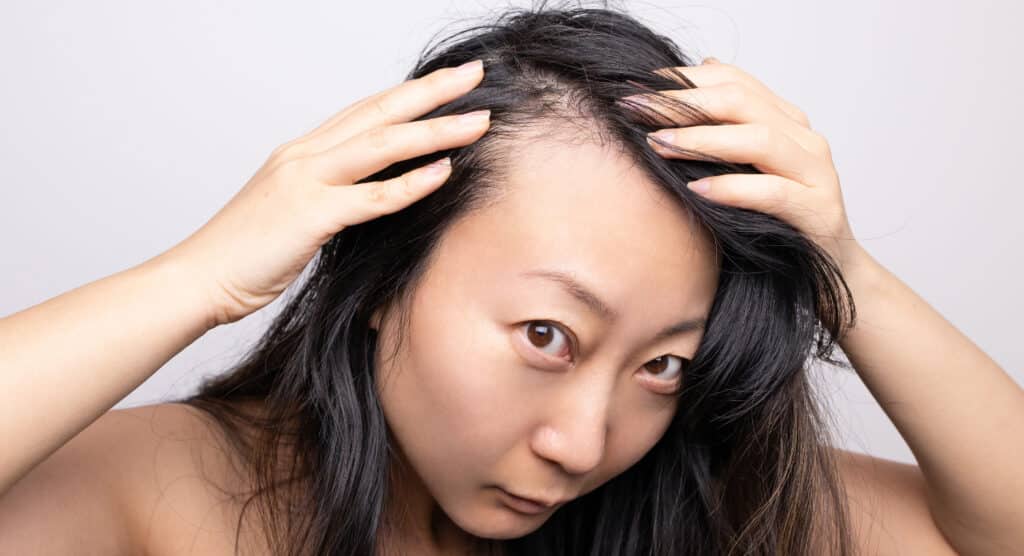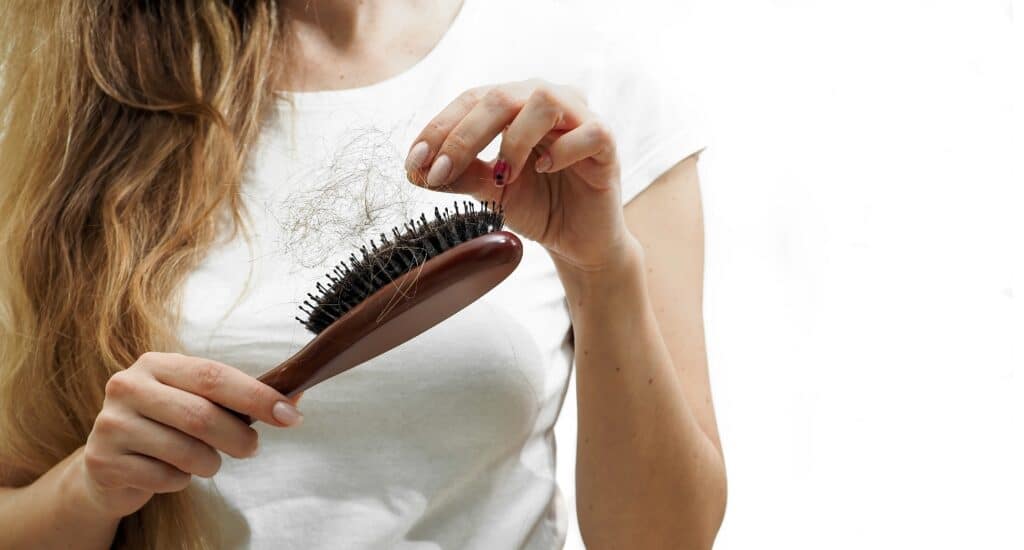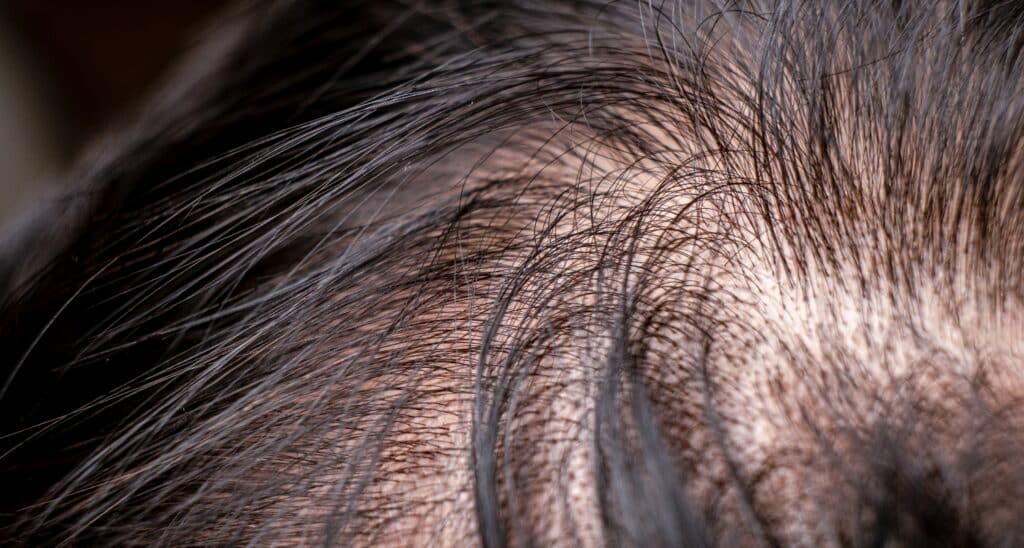Who doesn’t love lustrous locks? We all do! Thinning strands is a real threat to flaunting voluminous hair, but what is the cause of hair thinning in females? Can it be prevented or reversed? Let’s learn more about it and what can be done to combat it.
Hair Thinning ~ What is It?
Have you ever wondered about this? Hair loss and thinning are terms that are used interchangeably. But are they the same? The truth is, they aren’t!
Thinning is a condition where our hair shafts start growing back thinner or the diameter is lesser with each hair fall and growth cycle. Unlike hair loss, it doesn’t cause baldness as a rule. It also happens slowly and over a long period of time and is not abrupt or sudden.
There can be noticeable hair loss but the loss is not in patches rather, there’s a reduction in overall volume of hair. The hair count may go down but also there’s the widening of the part, receding hairline, etc. You know what’s funny? The triggers for both hair loss and thinning are often the same.
It’s Not a Male Thing!
When we talk about hair loss, or even thinning hair, many think it’s a problem reserved only for men. Did you know about 30%, if not more women experience hair loss? Male pattern baldness is more common but female hair loss pattern isn’t as obvious as men.
Male pattern hair loss is often characterized by baldness or loss of hair in patches, besides receding hairline making it more obvious. Female pattern baldness is often a gradual thinning, happens over a period of time where there’s loss of hair, overall reduction in volume and receding hairline. That’s probably why it looks like we suddenly notice and there’s a lot of change. But it doesn’t lead to baldness or loss of hair in patches. usually. Did you know it’s not just our head hair but body hair too that gets affected?
What is the Cause of Thinning in Females?
Hair thinning is extremely worrying for anyone. So, what causes it really? The main causative factors of overall hair thinning include aging and hormones. While hair loss can be a factor, it is often considered as vice versa. However, it goes both ways and is one of the major triggers.
There are other factors including certain medications or treatments, underlying health conditions, lifestyle, stress, nutritional deficiencies, etc. Inflammation is another factor that’s often overlooked.

Aging
With age, the hair shaft begins to thin. With age our hair follicles shrink and shafts begin to become weaker and thinner. This is also when women notice an overall reduction in volume and density with a lot of visible scalp areas, receding hairline and widening part. While it doesn’t happen like men with bald patches or loss of hair in bunches, it happens slowly and over a period of time.
Hormones
Androgenetic alopecia is a typical example for hormone related hair loss in women. Female pattern baldness as it is otherwise called in women, is one of the most common reasons for loss of hair. One’s genes will typically decide how and when it happens, but hormonal changes have a sway too.
It’s a relief that it is more like thinning and reduction in density and volume of hair than complete loss leading to bald spots or baldness like in men. Having that said, that’s not the only condition that’s related to our hormones.
Hair loss and thinning in women could be triggered due to other conditions including polycystic ovary syndrome (PCOS), pregnancy, thyroid, menopause, etc. During times like these, or in conditions like thyroid, our hormones are out of whack.
Also, androgens levels are high and that can cause thinning all on its own. We all know DHT is the result of androgen overdrive, right? There’s a reason it’s called androgenic alopecia, don’t you think so? Hair loss in women and hormones go hand in hand.
Hair Loss
Women losing hair is more common than we all think, but it’s less apparent and often takes a while before we even notice it happening. Having that said, hair loss could cause thinning hair, or vice versa. It’s one of the single major reasons that can cause thinning of hair.
Hair loss in women happens for numerous reasons. It could be trauma, stress, health issues, medications or treatments and what not. But, sudden or noticeable hair loss happens only in certain scenarios like a shock or trauma like a surgery or loss of a loved one, certain treatments like chemotherapy, etc.
In other cases, it is a gradual change where there’s a loss in hair volume and density. Though women lose hair, it is the changes like widening hair part, receding hairline, more spacing between our hair strands, thinning of strands, reduction in density, etc. By the time it catches our attention, it is already been a while.
Medications or Treatment
Like discussed earlier, certain treatments or medications can trigger hair loss and thinning. Blood thinners, antidepressants, anticoagulants and antibiotics are common culprits that cause hair loss.
How about birth control pills? They also cause a lot of changes in our body including hormonal changes. Some practitioners make it a point to tell women to come for a follow-up if they have lose more hair after taking the pills. Apparently, it is a prevalent side effect.
Certain treatments can also cause women to lose hair and more. What about chemotherapy or radiation? My mother-in-law noticed thinning of hair when she was on chemo as part of her cancer treatment. Another relative faced hair loss and lost hair completely during chemo, though it started as bald spots here and there. It differs with individuals, but that it affects hair remains common!
Health Conditions
Many health conditions can trigger hair loss and thinning. Some may be temporary, while some may cause you to lose hair until the issue is resolved.
How many of you noticed doctors ask if you noticed hair loss or thinning when they suspect thyroid disease? One of the key symptoms of thyroid is loss of hair and thinning.
What about high blood pressure? Typhoid? It should be renamed as hair fever or something, considering the amount of hair we lose, reduction in growth rate and volume. The silver lining in such scenarios is that hair grows back once the issue is addressed or resolved.
Lifestyle
Lifestyle encompasses a long list of factors that affect our hair. It could be anything from styling, to our diet, habits and whatnot!
Have you heard styling and treatments can lead to hair damage, loss of hair and thinning? Some issues that are a result of excessive styling are often irreversible. What about damaging hair styles like pulling up hair too tight? It can cause traction alopecia.
What about diets? It could be crash diets or takeaways and junk food, and all those processed foods that take a toll. Though hair falls, it will grow back once these lifestyle issues are fixed.
Not just these, what about pollution and other external factors? Everything could be a contributing factor! Yet again, we could take measures to counter some factors and it would only be a temporary hair loss.
Stress
Needless to say about stress, it’s one of the most common factors for every single one of us. It’s one of the key contributors for female pattern hair loss. It’s not just emotional stress, even physical stress should be taken into consideration.
Stress pushes more hair into resting or telogen phase (Telogen Effluvium) and kills new hair follicles that are trying to grow. Both these together not only cause hair loss, but also thinning of hair.
Did you know female pattern hair loss and alopecia areata can be aggravated or triggered by stress? Depending on how stress is managed, hair growth can go back to normal and hair loss can be reduced within a few weeks.
Nutritional Deficiencies
Our health determines every function in our body. Certain vitamins and minerals play a key role in our hair health. Did you know iron and folic acid are important for the health of your hair follicles?
Nutritional deficiency takes a toll on our hair. Biotin, zinc or even iron deficiency can trigger hair loss in women and men. Iron deficiency though is more a trigger in women than men.
To treat hair loss and thinning hair due to deficiencies, getting adequate nutrients help reverse hair loss and improve hair growth. This is probably why the Vitamins Revive Hair Growth Vitamins include key vitamins and minerals that are good for hair.
Inflammation
Inflammation is probably one of the most overlooked or ignored causative factors when considering female pattern hair loss or thinning hair. Inflammation of the scalp, or inflammation triggered by an underlying condition can both contribute to hair loss and thinning hair. Some conditions affect hair follicles and affect hair growth. Once the inflammation is addressed, hair loss can be curbed. Did you know inflammation is prevalent in those enduring female pattern hair loss or male pattern baldness?
Conclusion
Hair loss and thinning hair go hand in hand in most cases. Without addressing hair loss, improving hair growth alone won’t be enough. You don’t have to go for a hair loss treatment or check treatment options right off the bat.
Identifying the root cause or type of hair loss and thinning is the first step. It’s a good idea to consult a specialist as they can help identify the root cause and type of hair loss and suggest suitable solutions. They can even do certain blood tests if needed. Early treatment can help prevent your issues progressing towards permanent hair loss. As long as the hair follicle is healthy and not damaged, hair grows back.
Trying home remedies or other remedial measures when you notice hair loss is good. If it doesn’t further hair loss and promotes hair regrowth, reduces thinning of hair and hair fall and helps hair grow you’re on track.

FAQs
Losing how many strands per day is normal?
It’s normal to lose 50 – 100 strands a day. Hair loss is when women lose more than 125 strands a day.
Is Androgenetic Alopecia Hereditary?
Yes, androgenic alopecia is a hereditary hair loss condition that also causes gradual hair thinning. It’s a good idea to know the family history for this reason and try to take measures to prevent or delay or reduce impact.
Do certain medical treatments cause hair loss or thinning?
Yes, they do. A good example would be chemotherapy or radiation treatment that can cause complete baldness. It is usually temporary though in some cases it could be permanent. Even if hair does grow back after radiation, it can be thinner and the texture can change.
Are there ways to stimulate hair growth after losing hair?
Of course, there are natural and therapeutic options you can consider.
Does hair growth go down with age?
Hair growth slows with age but it can be curbed or delayed when taking early measures.
Are testosterone and DHT male hormones?
Yes, they are considered as male hormones. But women have a certain level of testosterone, just that it is considerably lesser as compared to men.
What’s the duration of anagen phase?
Anagen phase or active growth phase can be anywhere from 2 – 7 years, after which hair moves to transition phase.

